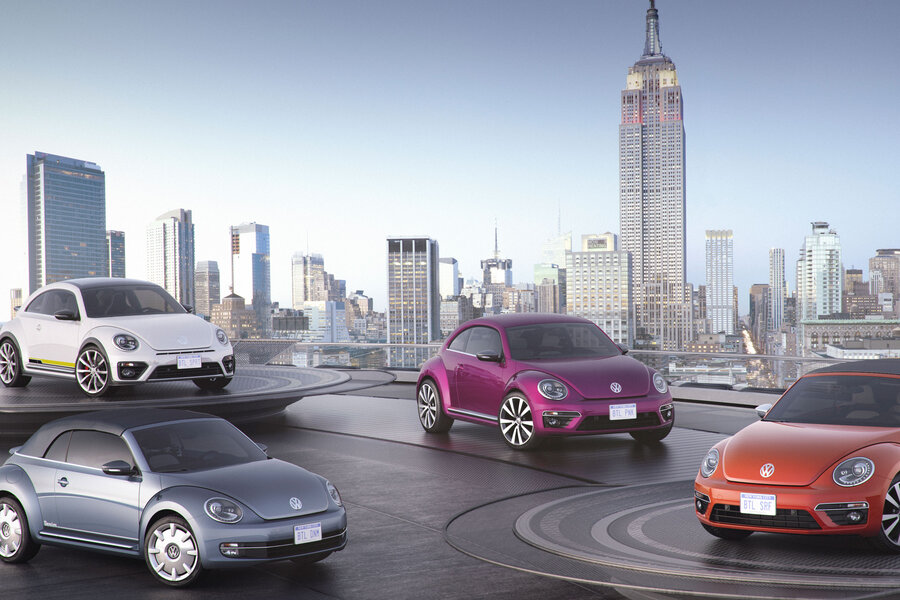Volkswagen celebrates 60 (technically 77) years of the Beetle
Loading...
At the New York International Auto Show this week, Volkswagen unveiled a range of special-edition Beetles for the car’s anniversary.
If you follow Volkswagen’s version of history, 60 years ago, America was introduced to the classic Volkswagen Beetle, and the German automaker decided to celebrate the iconic automobile with four new concept models.
It is hard to believe that for six decades in backseats across the country, generations of sibling have been harassing their brothers and sisters with a familiar cry of “Punch Buggy! No punch back!”
Beetle Convertible Denim
The throwback edition of the Beetle definitely goes to the Convertible Denim.
Based off the 1974 Jeans Bug, which had denim upholstery, this is the company’s first model of the jean-clad vehicle with a droptop, according to its press release. The car is powered by a 170-horsepower, 1.8-liter TSI (Turbocharged Stratified Injection) engine.
The convertible’s soft-top is made of dark blue, textured fabric “resembling denim,” which compliments the stonewashed blue metallic paint job and accented-gray mirror caps, side skirts, and body moldings. In varying shades of blue, the denim-like material also lines the interior of the car, as would be expected, and has “practical denim-look pockets” on the sides and backs of seats. The company says it will offer nine different colors for the production version of the Beetle Convertible Denim.
It should be noted that there doesn’t seem to be any actual denim in the design, which could speak of how terrible an idea it was to use real jeans as fabric in the 1974 version.
Beetle Pink Color Edition
While the type of light you stand in might determine if you see this car as bright metallic pink or Fanta grape purple, this is an impossible Beetle to miss.
Created in response to growing demand in the US and China for pink Bugs, the Beetle Pink Color Edition is a vehicle for those who do not mind the fuchsia-tinted spotlight. The limited edition concept automobile is a blinding metallic pink with the door mirror housings and side body moldings in contrasting gray. Volkswagen is waiting for the public’s response to the car, but is considering making the Beetle Pink a convertible, as well as a coupe.
In its press release, VW said it's already considering that an “even higher proportion of pink would be conceivable, based on feedback from the auto show.”
Beetle Convertible Wave
The Beetle Convertible Wave was “designed to enjoy the summer,” but the vehicle does not seem to offer much else.
The convertible is “habanero orange metallic” and has Tornado 19-inch aluminum-alloy wheels with chromed door mirrors.
The interior is a nod to the “high-end fashion and vehicles” of the 50s and 60s. There is a houndstooth pattern and “genuine” wood in the dashpad, which gives the car a surfboard look.
And that’s it.
It does not sound as if there are any plans for mass production of the Wave concept car. VW pointed to its Beetle Dune model, which will arrive in showrooms in 2016, as a good alternative to the Wave.
Beetle R-Line concept
The Beetle R-Line concept is meant to come across as an “extremely sporty statement.”
The car is powered by a 217-hp, 2.0-liter TSI engine and finished with a pearl white paint. The car has “aggressive” bumpers that feature large air vents surrounded by a high-gloss black molding that runs down the sides of the vehicle. A diffuser can be found on the back of the car, along with a large rear spoiler. The R-Line sits on top of 20-inch Monterey aluminum-alloy wheels and the concept car is 0.6 inches wider than a standard production vehicle.
The interior features upgraded sports bucket seats, and the dashpad, door inserts, and steering wheel spoke trim all have a carbon-fiber-style finish. In addition to the yellow stripes on the exterior paint trim, the inside includes yellow accents on different components in the car, including the decorative stitching.
Wait, how old is the Beetle?
Though Volkswagen says the Beetle is 60 years old, the math does not exactly add up.
As Jalopnik’s resident Bug-geek, Jason Torchinsky, points out, the first design and limited production of the original Ferdinand Porsche-engineered Beetle began in 1938. The initial model – which set the template for all designs that followed – was used by the Nazis to create vehicles for high-ranking officials during WWII, until Volkswagen fell under temporary British control in 1945.
The only mention of an origin date in VW’s press release is 1949, when the first two (and only) original Beetles were sold in America that year. (Something about the press labeling it “Hitler’s car” did not bode well with consumers.) The first American VW office was established in New Jersey in 1955, which could be the explanation for Volkswagen’s skewed math.
So, for all you sticklers for details, the Beetle is actually 77 years old.
All of the new Beetles are merely concept cars VW is considering for mass production. While few car writers walked away particularly impressed with the latest models, the Beetle is a car often associated with nostalgia. Long-time fans can look at the Bug and reminisce of their glory days with the vehicle, especially after it was rumored VW would halt production of the car.
[Editor's note: This article has been changed from its original version to correct a line about VW's first presence in the United States. The company opened its first Volkswagen Group of America office in New Jersey, not a factory.]







